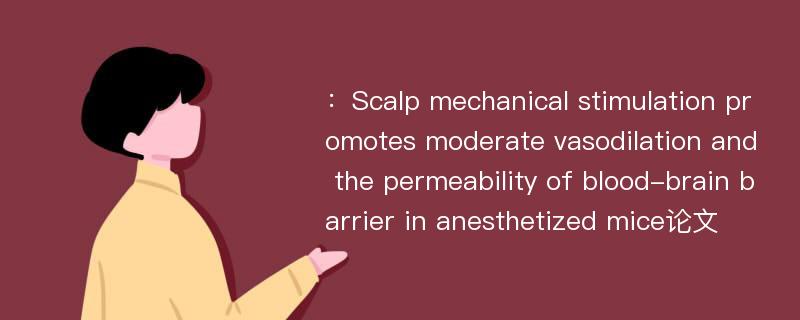
本文主要研究内容
作者(2019)在《Scalp mechanical stimulation promotes moderate vasodilation and the permeability of blood-brain barrier in anesthetized mice》一文中研究指出:OBJECTIVE Scalp mechanical stimulation, like combing, is one of the useful methods to keep brain health, which was historically recorded in traditional Chinese medicine thousand years ago. For the brain care, it is considered to promote cerebrovascular circulation to prevent alopecia,headache, neurasthenia, insomnia, memory deficits. However, few study was reported on its effect and how the scalp mechanical stimulation works on vascular functions. Therefore, in this study, we try to illustrate the effect of combing on the cerebrovascular. METHODS In vivo, the anesthetized mice have been used to observe the effects of scalp mechanical stimulation. Infrared thermal imaging has been used to measure the skin temperature; vasodilation has been evaluated by retro-orbital injection of FITC-dextran 150 ku; the permeability of Blood-Brain Barrier(BBB) was analyzed by confocal microscopy of FITC-dextran 40 ku extravasation and a spectrofluorometric assay of Even Blue extravasation.RESLUTS We found that scalp mechanical stimulation rather than on the back can maintain the body temperature, especially raise the temperature in the ears. Accordingly, a moderate vasodilatation of auricles′ capillaries(≤ 8 μm) was observed, the phenomenon of which did not occur combing on the back. Furthermore, the permeability of BBB was promoted by the assays of small molecular extravasation. In addition, in vivo imaging, the small molecular of FITC-dextran(40 ku) was found to transport far away from the blood vessels into the brain parenchyma with the lapse of time. CONCLUSION Scalp mechanical stimulation can work on vasodilatation of auricles and promotion of BBB under a biological condition. Combing, as a daily behavior, simple but may yield novel insights into neuroprotection.
Abstract
OBJECTIVE Scalp mechanical stimulation, like combing, is one of the useful methods to keep brain health, which was historically recorded in traditional Chinese medicine thousand years ago. For the brain care, it is considered to promote cerebrovascular circulation to prevent alopecia,headache, neurasthenia, insomnia, memory deficits. However, few study was reported on its effect and how the scalp mechanical stimulation works on vascular functions. Therefore, in this study, we try to illustrate the effect of combing on the cerebrovascular. METHODS In vivo, the anesthetized mice have been used to observe the effects of scalp mechanical stimulation. Infrared thermal imaging has been used to measure the skin temperature; vasodilation has been evaluated by retro-orbital injection of FITC-dextran 150 ku; the permeability of Blood-Brain Barrier(BBB) was analyzed by confocal microscopy of FITC-dextran 40 ku extravasation and a spectrofluorometric assay of Even Blue extravasation.RESLUTS We found that scalp mechanical stimulation rather than on the back can maintain the body temperature, especially raise the temperature in the ears. Accordingly, a moderate vasodilatation of auricles′ capillaries(≤ 8 μm) was observed, the phenomenon of which did not occur combing on the back. Furthermore, the permeability of BBB was promoted by the assays of small molecular extravasation. In addition, in vivo imaging, the small molecular of FITC-dextran(40 ku) was found to transport far away from the blood vessels into the brain parenchyma with the lapse of time. CONCLUSION Scalp mechanical stimulation can work on vasodilatation of auricles and promotion of BBB under a biological condition. Combing, as a daily behavior, simple but may yield novel insights into neuroprotection.
论文参考文献
论文详细介绍
论文作者分别是来自中国药理学与毒理学杂志的,发表于刊物中国药理学与毒理学杂志2019年06期论文,是一篇关于,中国药理学与毒理学杂志2019年06期论文的文章。本文可供学术参考使用,各位学者可以免费参考阅读下载,文章观点不代表本站观点,资料来自中国药理学与毒理学杂志2019年06期论文网站,若本站收录的文献无意侵犯了您的著作版权,请联系我们删除。
